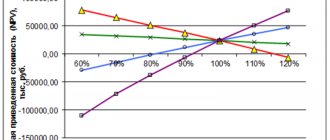The term “startup” appeared in the 70s to refer to companies with short operating cycles. The “dot-com boom” at the turn of the millennium provoked a rapid growth in the number of such companies, and at the beginning of the 21st century, “startup” became one of the most fashionable concepts associated with innovation and technical progress.
Despite the short economic cycles of startups, they all go through successive stages in their development - they are called startup stages. Most companies, however, cease to exist within a year—70% of them. Of the “survivors,” 40% will also close over the next year.
What is venture investment?
Investments in high-risk innovative projects aimed at generating excess income in the long term.
The above definition contains all the key disadvantages and advantages of venture investment.
Innovation
Innovation projects are aimed at finding and introducing a new product (business idea, technology, product or service) to the market. There are several options for innovation strategies, in particular:
- "New product - new market" . Involves developing new customer needs and forming a new market. Example: the production of the first mass-produced personal computer, Apple, in 1976 led to the creation of a new market. The best startup in history.
- "New product - old market" . It involves a large-scale capture of the existing market with the help of a new product designed to better satisfy the needs of customers. Example: the creation of the new Google search engine in 1997 turned the market upside down and brought investors super profits. It is noteworthy that a year after the start of work, Larry Page and Sergey Brin made an offer to Yahoo to sell the search engine, but they refused. And where is Yahoo now?
Risks
The high risks of the project are associated with the innovative nature of the developments and consist in the absence of any guarantees of return of the invested amounts. The investor must be prepared to lose his money in advance.
Long term
The long-term nature of the project is as follows:
- Long discrete investment period (3–5 years). On the path to success, the project goes through several stages, each of which requires cash injections. The development stage alone can last several years.
- Long payback period. In some cases - more than 10 years. Target time to reach break-even: 3 years after entering the project or 1 year after the launch of production and launch of the product on the market.
Extra income
The purpose for which a venture investor enters a project. The features of venture financing discussed above do not allow the investor to be satisfied with normal market profitability, otherwise the project will not be effective. The target effective annual rate of return is from 25–30 to 100% or more.
The investor expects to receive such profitability not through a share in current profits (for example, in the form of dividends), but only through the growth of the company’s capital value. The latter is determined by the market price of capital, which is expressed:
- the price of the company's shares on the stock market or;
- the price at which a third-party company is willing to buy the share (if the project does not go to IPO).
Advice! At the pre-final or final stage of the project, you can independently estimate the cost of capital by discounting future cash flows from the project. This cost is called strategic. To evaluate it, you will need an accurate understanding of the current income that the project generates, as well as potential future income (strategic financial plan for 5-10 years).
Other Features
- A significant amount of investment. Entry threshold: from 10 thousand dollars to several million. The average bill for a venture deal in Russia is about $1 million.
- Investment objects may be:
- small and medium-sized innovative companies with high growth potential;
- just people promoting an idea and already having successful experience in the past.
- Low forecast accuracy.
- Often, the transaction structure is complex and there are a large number of participants (private and public investors, intermediaries in the form of venture funds and management companies, etc.). The importance of legal and organizational issues.
If you invest in only one project and have a strategic interest in it, then you turn into a venture capitalist. In this case, it is vital for you to ensure maximum complete control and management (for example, becoming a CEO or joining the board of directors).
If you do not have a strategic interest, do not limit yourself to one project, but collect a portfolio of them, then you become a venture businessman. In this case, you must be internally prepared and focused on a timely exit.
The average life cycle of an investment in a venture business usually does not exceed 5–10 years. During this time, venture organizations must achieve such economic results that would allow investors to fully return their funds and exit the business with a profit.
What is a startup and when did it appear?
Definition of a startup
Startup
(from the English
startup
- starting, beginner) - an idea or solution to a problem based on the latest technological discoveries, the implementation of which requires material resources. A startup is also called a company or a team of developers that are ready to implement this very idea.
☝️
Interesting! The expression “old slipper” has also taken root in RuNet.
In general, there is no single definition of a startup due to ambiguous understanding. For some it is an idea, for others it is a company, but Steve Blank (the godfather of Silicon Valley) generally believes that a startup is a temporary structure created to search for a new business model.
A typical startup can be recognized by:
Innovation
- the first and key feature of a startup. It solves a problem that has never been tackled before or for which the existing solution is ineffective.
Manufacturability
— the solution to the problem is based on modern technologies, be it blockchain, facial recognition systems or new environmentally friendly dye for clothes.
Scientific-intensive activities
— you need to be able to write all these smart contracts and applications, design sensors, and derive the formula for a new paint in chemical equations. Therefore, the startup gathers qualified specialists under its wing, ready to work for an idea, food and faith in a bright future.
Narrow specialization
— the problem being solved is usually minor, and the company focuses on a small target group of people who really care about this problem. The old law of the market applies here: big companies solve big problems, while small ones pull up the tails that the big ones have forgotten about.
The birth of a startup
The last sign, by the way, is very clearly manifested in new (2018-2020) projects. For example, Understory Weather developed sensors to measure light and humidity in fields, and the Ukrainian Playseek launched an application to find partners for a morning jog and nearby sports grounds.
No matter how strange it may sound, the concept itself is older than 99% of the readers of this article. Back in 1939, David Packard and William Hewlett founded a high-tech development company near San Francisco, which they dubbed Startup. Now the company's name consists of the first letters of the founders' surnames - HP and is found on a good third of home and industrial PCs.
The word was forgotten for many years, until in the 70s it was dug up and Forbes and Business Week began to use it. Well, startups in the modern sense took root already in the 90s, when every second student with a PC and Internet access opened their own online store (dot-com era). These stores formally fell under the characteristics of a startup - technologically advanced, innovative, and their creators had no money.
We recommend watching an educational video that will clearly explain what a startup is:
What is a startup
Stages of venture investment
Pre-sowing stage
Search for new business ideas, technologies, products, projects under development or launch, promising young companies. It will take time and money. Selection criterion: the possibility of obtaining excess profits in the long term. Areas of analysis:
- Analysis of the possibility of scientific and technical implementation.
- Analysis of marketing feasibility.
- Economic feasibility analysis.
- Risk analysis.
- Analysis of required financial resources.
- Analysis of human resources. Competence of project managers (confidence in success), the presence of a cohesive team, the ability to attract qualified specialists to the project.
- Analysis of the legality and legal parameters of the project (necessary patents, licenses).
Sowing stage (feed)
Investor risk: maximum.
Completion of R&D and preparation for launch. At this stage it is important:
- Create a product prototype.
- Provide patent protection.
- Form a project team.
- Think over the legal and organizational structure of the project: the composition of investors, participants and management bodies.
- Decide on a strategy and formalize strategic business plans: marketing, production, financial.
- Assess the adequacy of funding (if necessary, use alternative sources of venture funding).
- Develop a schedule for launching the project.
Starting stage (start-up)
Investor risk: maximum.
The most resource-intensive stage. “Start-up capital” is required to organize production on a commercial scale and bring the product to market. Actions:
- Registration of the project within a legal framework: creation of a company, conclusion of agreements with investors, managers, project team.
- Providing the project with fixed assets (construction, acquisition of premises and equipment).
- Initial injections of working capital.
- Concluding agreements with suppliers and buyers. Primary advertising.
- Formalization of business processes.
The seed and start-up stages of venture financing are nicknamed the “valley of death” - 70–80% of projects die at these stages.
Early growth stage
Investor risk: large.
The project has been launched, the company has a commercial product. Actions:
- Final debugging of business processes and technologies.
- Investments in working capital.
- Initial promotion of the product to the market. Active marketing.
- Development and stabilization of supply and sales channels.
By the end of the stage, the company must reach a break-even point.
Expansion stage
Investor risk: medium.
The company is viable, but needs the means to gain strategic advantage through dramatic quantitative or qualitative growth. Actions:
- Investments in working capital.
- Active marketing, increasing sales volumes.
The goal of this stage is to capture market share and stabilize profits.
Pre-final stage (mezzanine)
Investor risk: minimal.
The stage preceding the sale of capital shares and exit from the project. A venture capital company ceases to be such. The status changes from high-risk to stable and growing. Actions:
- Reorganization and transformation of ownership (for example, creation of a subsidiary).
- Pre-sale preparation.
The ideal goal of the stage: the company should develop to a scale that allows it to carry out the IPO procedure and be able to place shares and other securities on the stock markets.
Exit
“Exit management” is carried out - the venture investor chooses an exit strategy. Kinds:
- IPO - initial public offering of shares on the stock market;
- SPO - secondary and subsequent placements of shares (additional issues);
- sale of the existing block of shares on the stock exchange;
- sale to a strategic investor (target acquisition);
- sale to a financial investor (for example, another fund);
- repurchase of shares by project managers;
- full or partial sale of assets.
In Russia, the first three methods are practically not used, which is due to an ill-conceived regulatory framework and the weak development of the stock market. Venture activity suffers greatly because of this.
The goal of the stage: obtaining maximum income.
Stages of development that any startup goes through
Analysts talk about five stages of a startup, each of which can be broken down into smaller phases.
- Pre-seed stage – the idea has not been tested, the potential audience and business model have not been outlined.
- Seed stage - a business idea undergoes verification and verification of the correctness of the choice of business model with the help of marketing research and trial sales.
- Launch stage – the company begins expansion into the mass market and develops marketing.
- Growth stage – following the growth of sales, the number of employees increases and the structure of the enterprise is formed.
- Exit stage - the startup is transformed into a classic company, the further development of which takes place according to other models.
How to become a venture investor?
Not as difficult as it seems at first glance.
Study the literature on venture business.
Decide on the area of investment that interests you and in which you understand (knowledge, practical experience).
Assess your available capital and opportunities for two-way diversification:
- several investors in one project;
- funds from one investor - into several projects.
Choose the forms of venture financing that suit you.
- Individual venture financing of investment projects with full control is suitable for venture capitalists and business angels.
- Crowdinvesting. Collective investment with minimal control. Large starting capital is not required. A good but risky way to build an investment portfolio.
- Syndicated investment with limited control. Golden mean.
Where to look for projects?
- Friends, publications in the media, business forums.
- Venture fairs.
- Startup exchanges and crowdfunding platforms. Discussed in detail in the article “Investing in Startups.”
- Associations, syndicates, clubs of venture investors and business angels.
- Pros: access to higher quality projects (than on exchanges), support from professional investors.
- Cons: additional costs (administrative, legal services, taxes).
- Venture funds. Discussed in detail in the article “Venture funds”. It makes sense to contact them only if you have a sufficient level of savings (from 300 thousand dollars).
How is a startup different from a good old business?
Startup and business differences
We have listed the characteristics of a startup above, but they rather characterize the type of activity of such projects and, if desired, they can be classified as large technology and IT giants that have been doing business for 30 years. But a startup is still not a business, and here’s why:
Monopoly
— it has already been said that startupers are pioneers, but another sign emerges from this fact. Because startups are always the first, then by definition they are monopolists in their niche and they do not need to work in a competitive environment. And the business follows the path already trodden by the startup and offers a similar or similar product, making the niche competitive.
Team
— Startup teams differ in their ideology, age and social status. If businesses are founded mainly by people over 30 who have managed to work in their industry and accumulate capital, then startupers are rarely over 30 and are mostly students who do not yet have a family. Therefore, with proper internal motivation, project participants are ready to sacrifice sleep and personal time in order to implement the idea.
Fast growth
— as a rule, in the first few months of existence (in fact, before the product is released), startups show growth of 4-7% per week, which attracts investors. The new solution quickly finds a response from the potential audience, and these are high sales in the future, which increase the value of the startup. Although before the product is released, it is not the customers, but the investors who raise its price.
☝️
Business, even if it also requires investment and is engaged in high-tech developments, always begins where there is certainty and expectation of profit.
An exception can be considered tech giants like Google, which can afford to work in the market they are studying and at the same time break into new niches. But such giants prefer to buy pioneering startups rather than found them.
Who are business angels
Business angels are private venture investors who invest personal funds in a project and are able to support its development until the final stage or until other investors enter. The term was formed at the beginning of the 20th century in the theatrical environment of New York. Single entrepreneurs invested in new theatrical productions and received money only if they were successful.
How are they different from other venture investors? Advantages and disadvantages:
- Limited investment opportunities. This is why angels alone finance projects only at the initial stages.
- Always invest their own capital rather than manage other people's money.
- They assume all the risk (there are no opportunities for diversification with other investors).
- They have a smaller number of transactions in their portfolio and are strategically interested in the success of the project.
- They show greater flexibility in choosing a project and use a simplified entry procedure (no unnecessary bureaucracy).
- Informal management style. They cooperate directly with the company's management without intermediaries (unlike corporate venture investors or funds).
- Take an active part in management. Personal practical experience and knowledge play a big role.
- Minus: they may, for one reason or another, prematurely “abandon” the project.
Business angel startups that have achieved significant success: Intel, Yahoo, Amazon, Google.
In Russia, the National Association of Business Angels (NABA) was created in 2009, according to which there are about 3,000 angels. True, no more than 10% of them are active. Reasons: high risks, lack of knowledge in specific areas of investment.
Applied startupology: the emergence and maturation of the project
Stages of a startup
Startups, like any other format of a commercial enterprise, have their own stages of growth and development. There are several concepts for the development of such projects:
Startup Genome Concept
The Startup Genome team studied more than 3,000 startups to understand what stages of growth they go through. According to their concept, there are 6 stages of a startup:
- Pre-seed
- there is an idea, but there is no developed mechanism for its implementation, no basic research, no team. - Seed
- a team is gradually being recruited that begins to monitor the market and develop an alpha roadmap of the project. With research results and a roadmap in hand, you can already start looking for investors. - A prototype
is not even an alpha, but the first model that will show whether the product can be implemented in principle and whether it works at all. - Alpha version
- the solution passes the first tests, shortcomings are identified and changes are made. This is still an ax to work so that the product has a clear concept. - A closed beta
is a finished, viable product that is tested on a small, closed group of consumers. Based on the results of the tests, conclusions are drawn and the work is carried out with a file. - Open beta version
- the solution is released to a wide audience, sales begin. Based on user feedback, minor modifications to the product are possible.
Note that Startup Genome rather showed the development of a startup as an idea, but not as a company. Although this aspect is also important.
Expanded concept
Startup idea development
Extended concept includes 3 stages
, divided into several stages. Overall it looks like an expanded Startup Genome concept:
Pre-startup stage
This stage includes the following sub-stages:
- Pre-seed.
- Seed.
- Prototype.
- Working prototype.
- Alpha version (alpha).
- Closed beta version.
- Open beta version (public beta).
This is exactly what Startup Genome was talking about, but the development doesn’t end there
Launch of the project
Launching a startup Based
on the results of the open beta, the final version of the product is released and sales begin. The startup reaches the stage of working with clients and receiving its first profit.
Post-startup stage
It begins when a startup transforms itself from a startup into a full-fledged company. Includes:
- Growth stage
- the final formation of the company, recruitment of staff, servicing all processes of the project - from manufacturing the product to its sale. - Expansion stage
- capturing new markets, opening new departments or entering the international market. In general, it attracts new customers. - Exit stage
- refers to the exit of investors. Can be implemented through a private sale of shares or a public sale (IPO).
Not all startups end up exiting - this stage depends on the sources of investment. Thus, hedge funds will prefer to exit the project, because their main goal is to make a profit, and already at the post-stage the startup’s growth slows down significantly. Well, private investors may prefer to remain in the share and receive a stable profit. In any case, the exit model should be envisaged at the stage of attracting investors.
Blank model
Launching a startup according to Blank
Blank's development model logically continues his understanding of a startup as a temporary structure. It provides:
- Identifying customers
- the team thinks through how the idea will solve customer problems, who these customers are and how popular it is in general. - Customer verification
- hypotheses from the first stage are tested in practice during market research, which should help identify the first customers. - Attracting consumers
- when there is a finished product and potential customers have been identified, the first sales and promotion of the product begin. - Creating a company
- turning a startup into a full-fledged company with an extensive structure to service all work processes.
Where to invest money?
Investments in new industries or business sectors are initially always venture capital, but over time they become classic (business processes are being worked out, competition is growing, profitability is falling).
At one time, investments in new methods of oil production, cars, even weapons and gambling were considered venture capital. In early Russia, investments in the military-industrial complex could be considered venture capital.
The current stage of development began in Silicon Valley and takes place under the auspices of information and computer technologies, as well as biotechnologies.
The venture industry is becoming attractive for investment for three reasons:
- The industry is actively conducting promising scientific and technological research. Example: Multipolar computer developments have led to an investment boom in Silicon Valley. Follow the science.
- In a specific geographic segment of the market, there is a lag behind leading countries. Example: the poor development of mobile technologies in Russia at the dawn of the millennium led to large investments in the segment of cellular operators. Study the experience of other countries.
- Innovations in one industry may be applicable to other sectors. Example: The development of computer technology has led to a technological revolution in the industrial sector. The process is still ongoing.
Venture capital funding abroad by industry over the past decade looks approximately as follows:
- information technology - 28%;
- healthcare - 25%;
- consumer services - 18%;
- business and financial services - 15%;
- energy - 8%;
- industrial and consumer goods - 6%.
The low share of investment in industry and energy is due to the conservative and inert nature of the industries, as well as the potentially large amounts of required investment.
The most successful venture investments in startups in the world: Standard Oil (Rockefeller), Apple, Microsoft, Google, General Electric, Twitter, YouTube, Amazon, Face Book.
Now let's turn our attention to venture investment in Russia.
From 2007 to 2013, the segment developed rapidly (5 times). After this, stagnation set in and continues to this day. The following trends have emerged:
- a decrease in the average check size (due to increased investor caution regarding venture assets);
- stagnation in the domestic market: according to firrma.ru estimates, the number of Russian transactions decreased by 20%;
- inertia and reorientation of large funds to the Western market (higher quality of projects, lack of currency risk);
- priority interest in projects at later stages (refusal to invest in projects at the seed and start-up stages);
- increase in the number of exits;
- reduction in state investment activity;
- rise of the business angel community.
Venture financing in Russia by industry in 2016:
- the share of investments in information technologies (software, Internet, mobile communications and telecommunications), according to various estimates, ranged from 80 to 90%;
- investments in medicine did not exceed 5–10%;
- the remainder came from the consumer market, industrial technology and energy.
No significant changes are expected in the coming years. Within the information technology sector, one can note a decline in interest in the e-commerce segment (reduction in consumer opportunities and exchange rate fluctuations), coupled with an increase in activity in the online services segment. Reasons: the need for working capital is lower; the payback period and margin are higher.
A striking example of a successful startup in Russia is the purchase of 48% of the shares of VKontakte by Mail.ru for a record amount for Runet of $1.47 billion. In 2021, not a single major transaction worth more than $100 million was completed in Russia. Among the significant exits, you can pay attention to the following venture transactions:
- $39 million. Output object: NikoMag (manufacturer of innovative nanostructured chemical products). Buyer: Nikohim. Seller: "Rosnano".
- $30 million Exit target: Pixonic (mobile game developer). Buyer: Mail.ru Group. Seller: AddVenture, Kite Ventures, QIWI co-founder Andrey Romanenko.
- The transaction amount is not disclosed (several tens of millions of dollars). Exit object: Gett (taxi ordering service). Buyer: Volkswagen. Seller: Inventure Partners (partial exit).
- Output object: Delivery Club (food delivery service). Buyer: Mail.ru Group. Salesman:
From the garage to the masses: a startup using the example of Oculus
Successful startup
This is where the theoretical part is over and we move on from scientific abstractions to the practical implementation of a startup. Let's look at how one of the most famous VR projects, Oculus
.
Stage 1: Pre-seed
Newfags won’t remember, but before these Oculos of yours, humanity had already experienced a boom in virtual reality in the 90s, when they sold huge helmets with soapy pseudo-3D graphics.
In 2009, a simple Californian guy, Lucky Palmer, became interested in virtual reality and wanted to buy one of these helmets. Monitoring auctions such as eBay and liquidation sales of equipment warehouses made it possible to obtain several samples, incl. and professional helmets. They all turned out to be rubbish and then 16-year-old Lucky had the idea of creating a really high-quality VR helmet.
Stage 2: Seed
Palmer had some design experience from his childhood fascination with technology, but did not know how virtual reality headsets worked. He began to systematically disassemble all the purchased samples, analyzing their design and identifying errors.
At this stage, Palmer took over all the financing, spending several tens of thousands of dollars, earned on his own, on his hobby (he did not consider it a startup).
Stage 3: Prototype
Launching a Startup
The first fruits of painstaking study of the technology were a series of Rift prototypes. Palmer shared them on the MTBS3D forum, as well as the results of his research. The guy independently mastered widescreen viewing, wireless communications and accelerometers.
Not perceiving his project as a commercial one, Lucky decided to raise funds on Kickstarter for spare parts for 100 units of his helmet. He planned to simply send these parts with assembly instructions to his crowdfunders.
Stage 4: Alpha version
A public presentation of the Oculus Rift prototype took place at Electronic Entertainment Expo 2012 and was held by id Software as part of the announcement of the development of Doom 3 and BFG Edition for virtual reality helmets. No, id Software did not become Palmer's investors. It’s just that on the Kickstarter forum, where Lucky published his project, John Carmack, the founder of id Software, happened to be there and the guy donated one sample of the helmet to such a respected person in the gaming world.
Even without investments, Carmack radically changed the nature of the project - not a few hundred gamers, but several thousand now knew about Oculus, and the news spread like wildfire.
Stage 5: Closed Beta
Startup success
After this presentation, Lucky Palmer registered the Oculus VR company and launched a full-fledged Kickstarter campaign. The campaign's goal was to raise $250,000, but the self-taught engineer received $2.5 million instead.
Why is this a closed beta stage? At the time of the Kickstarter campaign, customers were offered the Oculus Rift DK1, a developer version aimed at game creators. That is, a relatively limited group of users had to check the functionality.
☝️
Soon the main problems of the device were discovered - it caused nausea, motion sickness and ripples in the eyes. They tried to eliminate them in Rift DK2.
Stage 6: Open Beta
The first version for a wide audience was announced back in 2013 - this is the Oculus Rift CV1. But the model had to be modified so many times (taking into account comments on DK1-2) that pre-orders were opened only in 2016. Despite the price being twice as high as promised ($599 instead of $300), the first batch was completed in a few hours.
Meanwhile, in January 2014, Oculus VR came to the attention of Mark Zuckerberg and after a personal test of the helmet being developed, Facebook entered into a $2 billion deal with Oculus VR. Until 2016, Palmer was the technical director of the project, but was later forced to leave the company for political reasons. reasons.
In general, this is a typical startup story, with the only difference being that Oculus entered the world not through an accelerator or investors, but through crowdfunding. Therefore, the mentioned “exit” was not there - the investors did not sell the shares; instead, the entire startup was bought by the tech giant.
You can also note the share of luck in the story with John Carmack: not every industry leader is ready to advertise a startup “for thanks.” It’s not entirely clear whether all those who invested in the project on Kickstarter received their Oculus.
Where to look for cool and profitable startup projects
There are several options here.
Startup platforms and exchanges
Online platforms offer electronic catalogs of companies collecting investments. Of course, the likelihood of finding something revolutionary is extremely low, but there are good ideas here.
Global platforms like Seedinvest and WeFunder bring together investors and developers from all over the world. Start - from $10-100. Each market also has its own local projects, but here the audience is, of course, smaller and funds are collected more slowly.
Open startup databases
You can search open Internet sources, search public directories, forums and databases. Information can be filtered by the startup’s field of activity, expected profit and other parameters. It is important to understand that information in such sources can quickly lose relevance. Also, scammers often hang around here, waiting for investments in their wallets.
Watch the finals of competitions
The goal of the competition is to develop an innovative environment, attracting the attention of an interested public (potential clients and possible investments). Organizers can do this purely for charitable purposes and for a fee. It makes sense for an investor to take a closer look at the finalists of such competitions. Often you come across ones that are suitable for investment.
Investment strategies
Basic investment strategies:
- Milch cow. This is the name given to a startup that can take a large market share in the industry. In this case, it is more profitable for the investor not to wait until the company goes public and starts paying dividends to shareholders, but to profit as much as possible from sales. Hence the term "cash cow". The investor is not interested in going public. First of all, sales. This is often how they work with hype entertainment products, which provide enormous profits right away, but quickly go out of fashion.
- Merger. Another important and often considered investment strategy. In this case, the initial hope is to occupy part of the market, and then merge with another company in order to combine cash flows or become part of a well-established brand. In the event of a merger, the investor receives either a good buyout or a share in a large company, which is also a very good conversion.
- Exit to IPO. This strategy involves the company obtaining public status and entering the stock exchange as soon as possible. The benefit for the investor is that his share of the business is converted into shares and becomes more liquid. In addition, it becomes possible to buy shares of other companies, making a profit and hedging risks. For example, purchasing shares of successful competitors if things are not going well for us. It seems that they lost and made money.
Stage (stage): “Expansion”.
"Expansion"
– the goals of
the venture company
at this stage are business expansion, increasing sales volumes, market share, production volumes, office space, etc.
Finance that ensures the growth of a venture company
and expansion of its activities
(“Expansion capital” or “development capital” - Expansion Capital or Development Capital)
, help to achieve break-even operation or operate at a profit.
Possible ways to use venture capital
: financing the development of production facilities, market or product development, providing additional working capital.
The famous “ZeptoLab” and the beginning of their journey
Now a famous game developer, he was once an ordinary Russian startup project. At one time, promising developers were noticed by the Russian Ventures venture fund. $12 million was invested in the project.
Nowadays, the company's games are in unusually high demand. Only the famous domestic “Tetris” is more popular than their series of games. Active downloads have exceeded 400 million. The founders of the company are developing their product line in every possible way. The cartoon was launched on the YouTube platform. The idea also turned out to be popular. Total animation views number around 100 million. The company's most popular product is the famous game Cut the Rope. The product is in demand all over the world and several continuations of the series are in development. The company has representative offices in countries such as Japan. Offices are also located throughout Europe. Thanks to the fund's smart investments, Russian developers have become direct competitors of large foreign companies. The total cost of ZeptoLab is not known with certainty. But since the performance is extremely successful, the estimate is for many hundreds of millions of dollars. This is one of the examples of the most successful projects from venture funds.
Stage (stage): Initial “start-up” stage.
Venture company
at
the “Start-up” stage
does not have any long market history, is either at the very early stage of sales, or is at the organizational stage, or has already been running its own business for a short time, but has not yet sold its product for money.
The initial stage of "startup" -
The initial stage of financing is the provision of funds
a venture capital company
for product development and initial marketing.
The financing provided to venture companies
at this stage is called Start
-up
Capital.
Domestic online call service Zingaya
The project was launched in 2010. The main idea of the startup is the ability to make calls directly through an Internet browser. It is enough to make just a couple of clicks and you can be content with free and high-quality communication, which is not inferior to analogues from competitors. At one time, the project was supported by a Moscow venture fund. $3 million was allocated for the development of ideas and technology.
The project cooperates with many of the largest companies in Russia. Such as: MTS, Volkswagen, Promsvyazbank. Several years ago, several companies in America and Europe began to use the company’s services. Statistics make it clear that everything is fine with traffic and customer base. About 600 companies use their services, and an average of one and a half million calls are made per year. In recent years, the company's turnover has grown by 450%, and profits are approaching 1 million a year. Now, the company has also attracted foreign investment funds. The idea and product are constantly evolving, the company is among the TOP 50 most successful venture startups. The main advantages of the platform are: quality of communication, low response of the server part and a perfectly adapted user interface.










